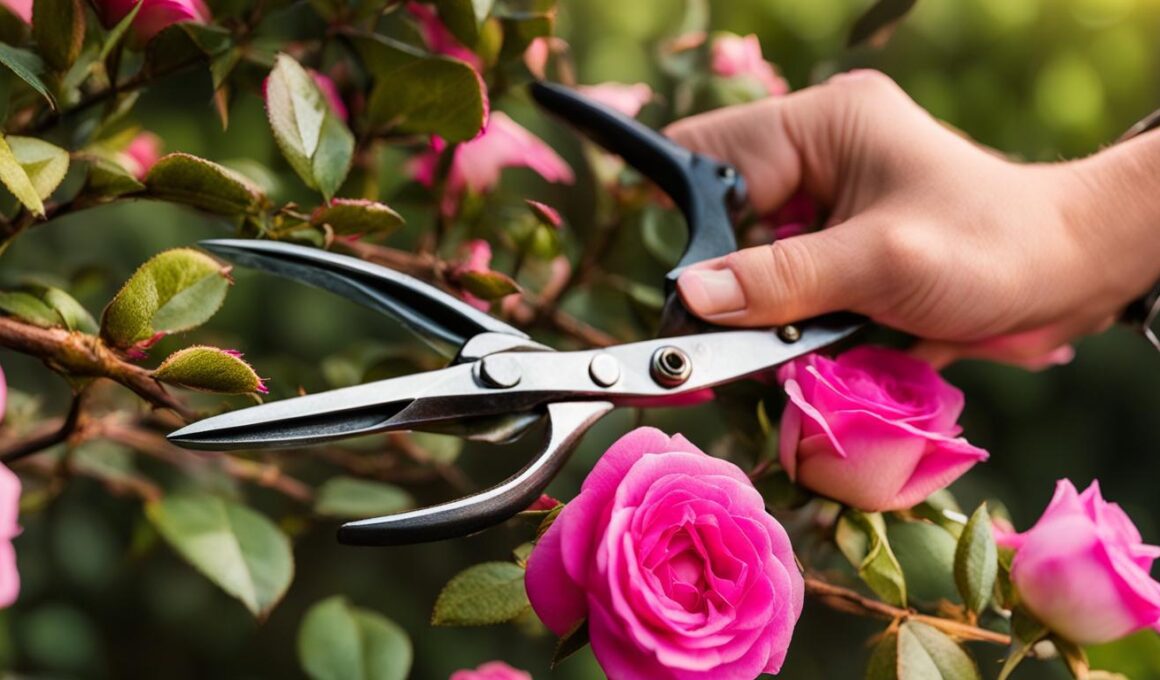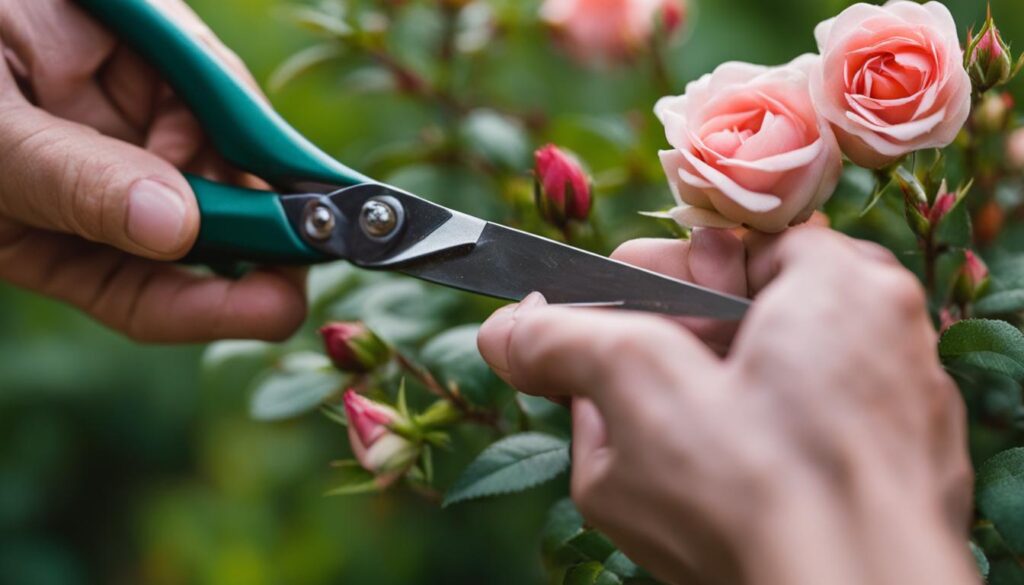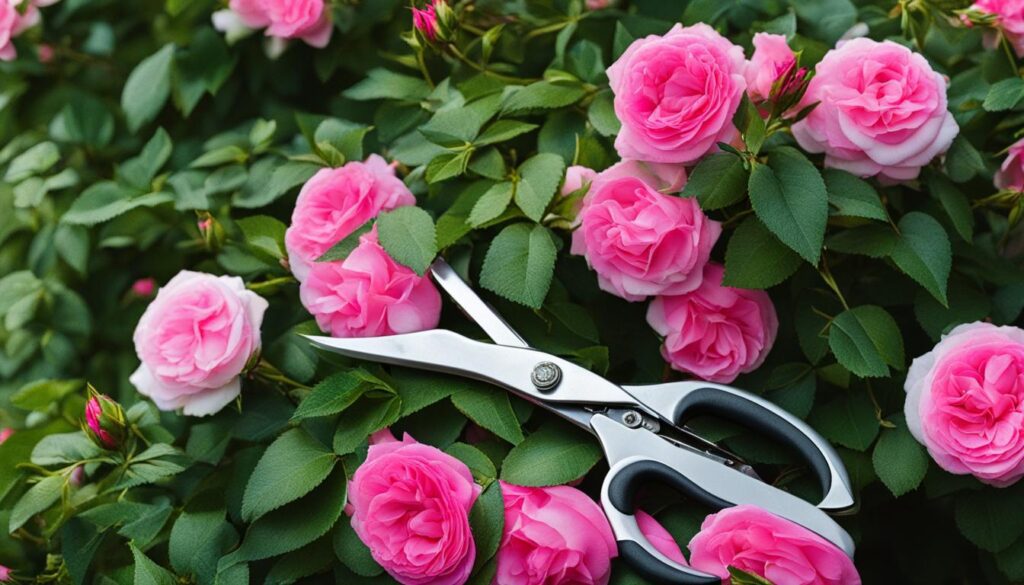Drift Roses are a fantastic addition to any garden, with their low-maintenance nature and stunning blooms. While these roses don’t necessarily require pruning, a little summer pruning can go a long way in shaping the plants and encouraging heavier flowering. In this guide, we’ll provide you with essential tips on how to prune your drift roses during the summer months.
Key Takeaways:
- Regular summer pruning can help shape your drift roses and promote more abundant blooms.
- Prune your drift roses in late winter or early spring before new leaves emerge.
- Deadhead spent blooms throughout the blooming season to encourage more buds and flowers.
- Cease pruning two months before the first-frost date in your area.
- Proper fertilization, watering, and soil pH maintenance are also important for the health of your drift roses.
Benefits of Pruning Drift Roses
Pruning Drift Roses offers numerous benefits that contribute to the overall health and beauty of these lovely plants. By removing dead, damaged, or diseased branches, pruning helps maintain the plant’s overall health and vitality. Additionally, pruning stimulates continued blooming by encouraging the growth of new buds and blooms. This results in a more abundant display of colorful flowers throughout the blooming season.
Furthermore, pruning promotes improved air circulation within the plant, which is essential for preventing foliar diseases. Proper airflow helps to keep the foliage dry and reduces the risk of fungal infections. Additionally, pruning can shape the plant and prevent the formation of rose hips. Rose hips are the seed pods that form after flowering, and by removing them through pruning, the plant’s energy is redirected towards producing more blooms.
Overall, the benefits of pruning Drift Roses are twofold. Not only does it contribute to the plant’s health and vitality, but it also enhances the plant’s aesthetic appeal by promoting a more compact, well-shaped growth habit. Whether you have a small garden or a large landscape, pruning Drift Roses can help you achieve a beautiful, thriving display of blooms.
Promoting Health and Abundance
“Pruning Drift Roses helps maintain their health and encourages continued blooming.”
Enhancing Aesthetic Appeal
“Pruning shapes Drift Roses and prevents the formation of rose hips, redirecting energy towards more blooms.”
| Benefits of Pruning Drift Roses |
|---|
| Maintains overall plant health |
| Stimulates continued blooming |
| Improves air circulation to prevent foliar diseases |
| Shapes the plant for a more compact, well-formed growth habit |
| Prevents the formation of rose hips, redirecting energy towards more blooms |
As you can see, pruning Drift Roses offers a wide range of benefits. Whether you’re aiming to maintain the plant’s health, enhance its aesthetic appeal, or simply enjoy an abundance of beautiful blooms, regular pruning is an essential practice for any Drift Rose enthusiast. By understanding and harnessing the benefits of pruning, you can ensure your Drift Roses thrive and provide a stunning display of color and fragrance in your garden or landscape.
When to Prune Drift Roses
Pruning drift roses at the right time is crucial for their overall health and blooming performance. The ideal time to prune drift roses is in late winter or early spring, just before new leaves start to emerge. Pruning at this time ensures that the plant has a good habit and healthy blooms throughout the growing season. However, it’s important to consider the local climate and weather forecasts before pruning.
To determine the right timing for pruning, pay attention to the threat of frost and the blooming of forsythia in your area. Pruning too early can result in unnecessary dieback if there is still a risk of frost. Wait until the threat of frost has passed and the forsythia are in full bloom, as this is a reliable indicator that it’s safe to prune your drift roses.
By pruning at the right time, you can promote vigorous growth, increase blooming, and maintain the overall health of your drift roses.
Table: Pruning Timing for Drift Roses
| Timing | Action |
|---|---|
| Late winter or early spring | Prune before new leaves emerge |
| After the threat of frost has passed and forsythia are in full bloom | Safe time to prune |
How to Prune Drift Roses
Proper pruning is essential for maintaining the health and appearance of your Drift Roses. Here are some pruning techniques to help you get started:
1. Pruning Equipment
Use sharp bypass pruners or other quality pruning tools to make clean cuts. Dull or rusty tools can damage the plant and increase the risk of disease.
2. Hard Pruning
For a more drastic pruning, cut the rose back to about 4 to 6 inches above the ground. This will help rejuvenate the plant and promote healthy new growth. It’s best to do this in late winter or early spring before new leaves emerge.
3. Deadheading
To encourage continuous blooming, deadhead spent flowers by making a cut at the base of the flower cluster stem. This will redirect the plant’s energy towards producing more blooms.
4. Proper Technique
When making pruning cuts, angle them at about 45 degrees and make the cut about 1/4 inch above a bud of an outward-facing leaflet. This will promote outward growth and prevent disease.
| Pruning Technique | Timing | Benefits |
|---|---|---|
| Hard Pruning | Late winter or early spring | Promotes healthy new growth and rejuvenation |
| Deadheading | Throughout the blooming season | Encourages continuous blooming and prevents rose hips |
| Proper Technique | Anytime when pruning | Encourages outward growth and prevents disease |
Other Care Tips for Drift Roses
Aside from pruning, there are other important care tips to keep your Drift Roses thriving. Proper fertilization is key to providing the necessary nutrients for healthy growth and abundant blooms. After the late winter pruning, apply a rose food or organic plant food every six weeks during the growing season. This regular feeding regimen will ensure that your roses have the essential nutrients they need to flourish. It’s important to cease fertilization two months before the first-frost date to allow the plants to harden off for winter.
In addition to fertilizing, proper watering is crucial for the overall health and vigor of your Drift Roses. These plants prefer moist but well-drained soil. When watering, it’s important to strike a balance and avoid over-watering, as excessive moisture can lead to root rot. After planting, water deeply to establish the root system, and then water as needed to keep the soil moist, not wet. It’s best to water in the early morning hours to allow foliage to dry and prevent the onset of fungal diseases.
To help maintain the optimal soil conditions for your Drift Roses, it’s important to monitor the pH level of your soil. These roses thrive in mildly acid to neutral soil with a pH ranging from 6.0 to 7.0. You can test the pH of your soil using a soil pH tester probe, available at most garden centers. If the soil pH is too high (alkaline), you can add pelletized limestone to raise it. Conversely, if the soil pH is too low (acidic), you can apply soil sulfur, aluminum sulfate, or chelated iron to lower it. Adding organic compost or using it as mulch can also increase acidity and maintain acid soil conditions.
Summary:
- Fertilize your Drift Roses regularly after pruning, using a rose food or organic plant food.
- Water your roses deeply after planting, and keep the soil moist, not wet, during the growing season.
- Monitor the pH level of your soil and make adjustments as necessary to maintain the ideal range of 6.0 to 7.0.
Table: Essential Care Tips for Drift Roses
| Aspect | Tips |
|---|---|
| Fertilization | Apply rose food or organic plant food every six weeks during the growing season. Cease fertilization two months before the first-frost date. |
| Watering | Water deeply after planting, and then keep the soil moist, not wet. Water in the early morning hours to prevent fungal diseases. |
| Soil pH | Maintain mildly acid to neutral soil with a pH ranging from 6.0 to 7.0. Test soil pH and make adjustments using appropriate amendments. |
Soil pH and Testing
In order to ensure the optimal growth and health of your Drift Roses, it is important to understand and maintain the correct soil pH. The pH level of the soil directly affects the availability of nutrients to the plants, and Drift Roses thrive in mildly acid to neutral soil with a pH ranging from 6.0 to 7.0.
To determine the pH level of your soil, it is recommended to conduct a soil pH test in the planting area. You can easily test the soil pH using a soil pH tester probe, which is readily available at most gardening stores. Once you have the test results, you can take appropriate measures to adjust the pH level if necessary.
If your soil pH is too alkaline (above 7.0), you can raise the pH by adding pelletized limestone. On the other hand, if your soil pH is too acidic (below 6.0), you can lower the pH by applying soil sulfur, aluminum sulfate, or chelated iron. Another way to increase acidity and maintain acid soil conditions is by incorporating organic compost into the soil or using it as mulch.
By ensuring the correct soil pH for your Drift Roses, you will create an environment that allows them to thrive and reach their full potential, resulting in healthy plants and beautiful blooms.
Table: Quick Guide to Soil pH Adjustment
| Action | To Raise pH (Make it More Alkaline) | To Lower pH (Make it More Acidic) |
|---|---|---|
| Additive | Pelletized limestone | Soil sulfur, aluminum sulfate, chelated iron |
| Application | Spread evenly over the soil surface and water in | Follow package instructions for application rates and mix into the soil |
| Timing | Apply in fall or winter, allowing time for the pH to adjust before planting | Apply in fall or winter, allowing time for the pH to adjust before planting |
| Notes | Retest soil pH after application to ensure desired pH level is achieved | Retest soil pH after application to ensure desired pH level is achieved |
Tips for Watering Drift Roses
Proper watering techniques are essential for the health and vitality of your Drift Roses. These low-maintenance plants require moist but well-drained soil to thrive. Avoid constantly soggy or wet soil, as it can lead to root rot and other issues. Here are some tips to ensure your Drift Roses receive the right amount of water:
- Water deeply after planting to establish a strong root system.
- During the first active growth season, water as needed to keep the root ball and surrounding soil damp to moist.
- It’s recommended to water in the early morning hours to allow the foliage to dry before evening, reducing the risk of fungal diseases.
- Consider using an automated irrigation system for consistent and efficient watering.
- Established Drift Roses are drought-tolerant, but during prolonged periods of drought in the summer, they may require supplemental irrigation.
- Water only if necessary when you see signs of wilting or the soil is dry.
Watering Schedule
The watering schedule for Drift Roses may vary depending on factors such as climate, soil type, and rainfall. As a general guideline, aim to provide 1 to 1.5 inches of water per week, including rainfall. Monitor the moisture levels in the soil by checking the top few inches with your finger. If the soil feels dry, it’s time to water.
Remember that it’s better to water deeply and less frequently rather than shallowly and frequently. Deep watering encourages the roots to grow deeper into the soil, resulting in stronger and more resilient plants.
Table: Signs of Over-Watering and Under-Watering
| Signs of Over-Watering | Signs of Under-Watering |
|---|---|
| Yellowing or wilting leaves | Wilting leaves that don’t recover after watering |
| Root rot or fungal diseases | Leaves that appear dry or crispy |
| Musty or foul odor from the soil | Stunted growth or lack of new growth |
Monitor your Drift Roses closely and adjust your watering routine accordingly. By providing just the right amount of water, you can help your roses thrive and enjoy a beautiful display of blooms throughout the season.
Are the pruning tips for trimming drift roses in summer the same as the step-by-step guide for trimming drift roses?
Yes, the pruning tips for trimming drift roses in summer are the same as the step-by-step guide for trimming drift roses. Following the trimming drift roses stepbystep guide ensures proper maintenance and promotes healthy growth. Summer pruning helps remove dead or diseased branches, encourages new blooms, and maintains the shape of the bush.
Conclusion
Pruning Drift Roses in summer is an essential part of caring for these beautiful plants. While they don’t necessarily require pruning, regular pruning can help shape the plants and promote heavier blooms. By following these essential tips, you can ensure the health and vitality of your Drift Roses and create a stunning rose garden.
Remember to prune your Drift Roses in late winter or early spring before new leaves start to emerge. This will encourage a good habit and healthy blooms throughout the growing season. Additionally, deadheading spent blooms throughout the blooming season will redirect the plant’s energy towards producing more beautiful flowers.
In addition to pruning, it’s important to provide proper fertilization and watering for your Drift Roses. Feed them after the late winter pruning and regularly fertilize during the growing season. Water your roses deeply after planting and keep the roots moist, but avoid over-watering to prevent root rot. By maintaining a balanced soil pH and following a proper watering schedule, you can ensure optimal conditions for your Drift Roses.
So, get ready to enjoy the rewards of your efforts as you watch your Drift Roses thrive and bloom abundantly. With these summer pruning tips and the right care, your rose garden will be a sight to behold.
FAQ
Do Drift Roses require pruning?
While Drift Roses do not require pruning, regular pruning can help shape the plants and promote heavier flowering.
When is the best time to prune Drift Roses?
The ideal time to prune Drift Roses is in late winter or early spring before new leaves start to emerge.
How should I prune Drift Roses?
When pruning Drift Roses, use sharp bypass or other pruners to make clean cuts. For hard pruning, cut the rose back to about 4 to 6 inches above the ground.
What are the benefits of pruning Drift Roses?
Pruning Drift Roses helps maintain the plant’s health by removing dead, damaged, or diseased branches. It also encourages continued blooming and improves air circulation through the plant.
How often should I fertilize Drift Roses?
Feed Drift Roses after late winter pruning and every 6 weeks during the growing season with a rose food or organic plant food.
How often should I water Drift Roses?
Drift Roses prefer moist but well-drained soil. Water deeply after planting, and then water as needed to keep the roots moist, not wet.
How do I test the pH of my soil?
You can test the pH of your soil using a soil pH tester probe.
What soil pH do Drift Roses prefer?
Drift Roses thrive in mildly acid to neutral soil with a pH ranging from 6.0 to 7.0.
How can I adjust the pH of my soil?
You can add pelletized limestone to raise the pH (make it more alkaline) or apply soil sulfur, aluminum sulfate, or chelated iron to lower the pH (make it more acidic).
Can I prune Drift Roses in the summer?
Pruning Drift Roses in summer is an essential part of their care routine. Regular pruning can help shape the plants and promote heavier blooms.











